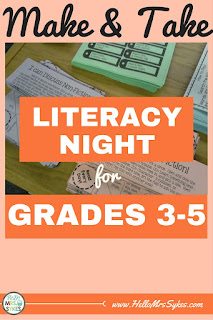Supporting Struggling Readers in Grades 3-5, Part 4
Today is the fourth day in my (slightly occasional) series to empower teachers, Supporting Struggling Readers in Grades 3-5. If you are new to the series, or want to see what the hype is about, click on the button below to visit the other posts in this series.
So far, you've created an Assessment Binder, made your list of struggling readers, assessed Fluency, and assessed Comprehension.
Our focus today is Decoding!!
Decoding sounds scary, so you can call it Phonics if you want. Basically, you want to see what they already know about letters and sounds so you can target their instruction accordingly. Here's an example: I was a Literacy Coach with a 5th grade teacher (who is an amazingly awesome teacher), and she said she didn't understand what else to do for her struggling reader. She had already assessed fluency and comprehension, and was targeting those areas with little results. We worked out a plan of attack - fast and easy - the Names test. After we analyzed the data, she turned to me and said "Donita doesn't understand vowels! I can fix this with a few targeted lessons!" And she was off and running...
Truly, once you dig deeper to find out the underlying issues, your student can make great strides in their reading.
So far, you've created an Assessment Binder, made your list of struggling readers, assessed Fluency, and assessed Comprehension.
Here's a quick and easy way to assess decoding: The Names Test. (Cunningham, 1990; Dufflemeyer and Colleagues, 1994) If you want to read the research, here's a link from The Reading Teacher. It's easy, research based, and fast! Here's the low down:
Now, target your instruction to hit these areas. To make it faster, form some strategy groups that you hit several times a week on the phonics skill - vowels, anyone? There are tons of resources available for phonics with lower grade students, but you'll need to be sure to alter these to make them more appropriate for the upper grades students. Oddly enough, they don't get excited about cute graphics as the younger ones do, and they might run from the room if you give them a copy of Miss Wishy Washy.
Here's a quick and easy way to assess decoding: The Names Test. (Cunningham, 1990; Dufflemeyer and Colleagues, 1994) If you want to read the research, here's a link from The Reading Teacher. It's easy, research based, and fast! Here's the low down:
- Print the Names Test Directions.
- Print the List of Names.
- Print the Scoring Sheet (1 per student).
- Tell the student to pretend they are the teacher calling out the roll. They are to do their best to pronounce the words. Do not help them. If they struggle, just say "Do your best." Record checks for correct responses, and write the incorrect responses. Give them a sticker or a high five, and send them back to their work. :)
- Score the assessment. Here's my favorite version to use of the scoring sheet, since it puts the names in the order your students will say them. Use your favorite colored pen to circle the phonetic elements they missed. Tally them up.
- Analyze the information. Where are most of their mistakes? That is your target area.
Now, target your instruction to hit these areas. To make it faster, form some strategy groups that you hit several times a week on the phonics skill - vowels, anyone? There are tons of resources available for phonics with lower grade students, but you'll need to be sure to alter these to make them more appropriate for the upper grades students. Oddly enough, they don't get excited about cute graphics as the younger ones do, and they might run from the room if you give them a copy of Miss Wishy Washy.
I've put together a few resources for y'all, and they are all classroom tested, designed by me during the years spent as a literacy specialist/literacy coach in grades K-5. I've also bundled them all together - save a few bucks! Each set is a week of interventions with small group lesson plans, activities, printables and games.
 |
| Bundle Pack #1 |
Next time, we'll be answering the FAQs. See you then!!






I love the Names test! What I particularly like is that you can administer it without the kid necessarily knowing it's a test. Sometimes I tell them I need them to help me check a list of names for the principal, or something like that, and they totally believe me.
ReplyDeleteThis is a really great series. Most of these are things I know about and am doing, but I know not everyone does and it's always good to read a refresher! Thanks, Jen!
Jenny
Luckeyfrog's Lilypad
I'm LOVING this series!!! I'd never heard of the Names test, such a great way to access the students decoding! One question, I can't find the next blog in the series. PLEASE HELP! I'm so excited to learn all I can so that I'll be reading in August! Thanks again for all of your help!!!
ReplyDeleteThis series has been a lifesaver!!! I have a few struggling readers this year, and didn't even know where/how to begin with them! Now I have a plan.. Thank you!!
ReplyDelete